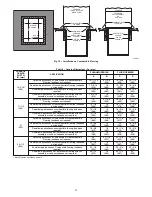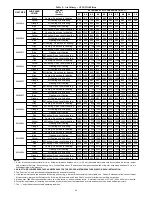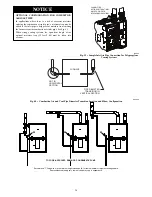
34
VENTING
NOTE
: Planning for the venting system should be done in
conjunction with planning for the ductwork, drainage, and furnace
accessories, such as air cleaners and humidifiers. Begin assembling
the venting system
AFTER
the furnace is set in place in the
required orientation.
Venting for this furnace shall follow all Local codes for Category
IV venting systems. This furnace is CSA approved for venting
with PVC/ABS DWV venting systems. This furnace is also CSA
approved for venting with M&G DuraVent
R
PolyPro
R
polypropylene venting systems.
NOTE
:
THESE INSTRUCTIONS
DO NOT
CONTAIN
DETAILED
INSTALLATION
INSTRUCTIONS
FOR
POLYPROPYLENE VENTING SYSTEMS.
Refer to the
polypropylene
venting
system
manufacturer’s
installation
instructions for the polypropylene venting system installation.
NOTE
: When using polypropylene venting systems, all venting
materials used, including the vent terminations, must be from the
same manufacturer.
Special Venting Requirements for Installations in
Canada
Installation in Canada must conform to the requirements of CSA
B149 code. Vent systems
must
be composed of pipe, fittings,
cements, and primers listed to ULC S636. The special vent
fittings, accessory concentric vent termination kits and accessory
external drain trap available from the furnace manufacturer have
been certified to ULC S636 for use with those Royal Pipe and
IPEX PVC vent components which have been certified to this
standard. In Canada, the primer and cement must be of the same
manufacturer as the vent system – GVS-65 Primer (Purple) for
Royal Pipe or IPEX System 636, PVC/CPVC Primer, Purple
Violet for Flue Gas Venting and GVS-65 PVC Solvent Cement for
Royal Pipe or IPEX System 636
(1)
t, PVC Cement for Flue Gas
Venting, rated Class IIA, 65 deg C. must be used with this venting
system - do not mix primers and cements from one manufacturer
with a vent system from a different manufacturer. Follow the
manufacturer s instructions in the use of primer and cement and
never use primer or cement beyond its expiration date.
The safe operation, as defined by ULC S636, of the vent system is
based on following these installation instructions, the vent system
manufacturer s installation instructions, and proper use of primer
and cement. All fire stop and roof flashing used with this system
must be UL listed material. Acceptability under Canadian standard
CAN/CSA B149 is dependent upon full compliance with all
installation instructions. Under this standard, it is recommended
that the vent system be checked once a year by qualified service
personnel.
The authority having jurisdiction (gas inspection authority,
municipal building department, fire department, etc.) should be
consulted before installation to determine the need to obtain a
permit.
*IPEX System 636™ is a trademark of IPEX Inc.
Consignes spéciales pour l’installation de
ventilation au Canada
L’installation faite au Canada doit se conformer aux exigences du
code CSA B149. Ce systême de ventillation
doit
se composer de
tuyaux, raccords, ciments et apprêts conformes au ULC S636. La
tuyauterie de ventilation des gaz, ses accessoires, le terminal
concentrique mural ainsi que l’ensemble du drain de condensation
extérieur fourni par le fabricant de cette fournaise ont été certifiés
ULCS 636 pour l’application des composantes Royal Pipe, IPEX
PVC qui sont certifiées à ce standard. Au Canada, l’apprêt et le
ciment doivent être du même fabricant que le système
d’évacuation. L’apprêt GVS-65 (Purple) et le ciment-solvant
GVS-65 doivent être utilisé avec les Royal Pipe. Système IPEX
636, apprêt PVC/CPVC, Purple pour évacuation des gaz de
combustion et
système IPEX 636(1)t, ciment PVC pour
évacuation des gaz de combustion, coté classe IIA, 65 deg C.
doivent être utilisés avec le système d’évacuation IPEX 636 – Ne
pas combiner l ’apprêt et le ciment d’un manufacturier avec un
système d’évacuation d’un manufacturier différent.
Bien suivre les indications du manufacturier lors de
l utilisation de
l’apprêt et du ciment et ne pas utiliser ceux-ci si la date
d expiration est atteinte.
L’opération sécuritaire, tel que définit par ULC S636, du système
de ventilation est basé sur les instructions d’installation suivantes,
ainsi que l’usage approprié de
l apprêt et ciment. Tout arrët feu et
solin de toit utilisés avec ce système doivent être des matériaux
listés UL. L’acceptation du standard Canadien CAN/CSA B149
est directement relié à l’installation conforme aux instructions ci-
haut mentionnées. Le standard Canadien recommande l’inspection
par un personel qualifié et ce, une fois par année.
Les autoritées ayant juridiction (inspecteurs de gas, inspecteurs en
bâtiments, département des incendies, etc) devraient être consultées
avant l’installation afin de déterminer si un permis est requis.
















































